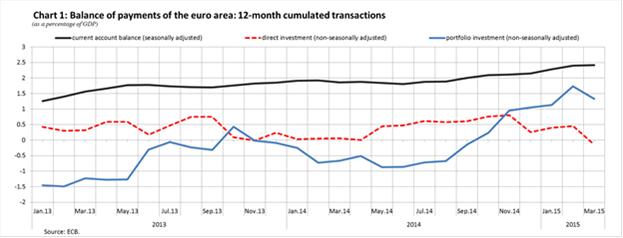Euro area monthly balance of payments (March 2015)
- In March 2015 the current account of the euro area recorded a surplus of €18.6 billion. [1]
- In the financial account, combined direct and portfolio investment recorded a decrease of €4 billion in assets and an increase of €39 billion in liabilities.

Current account
The current account of the euro area recorded a surplus of €18.6 billion in March 2015 (see Table 1). As in previous months, this reflected surpluses for goods (€21.6 billion), services (€5.5 billion) and primary income (€2.6 billion), which were partly offset by a deficit for secondary income (€11.2 billion).
The 12-month cumulated current account for the period ending in March 2015 recorded a surplus of €244.5 billion (2.4% of euro area GDP), compared with €186.1 billion (1.9% of euro area GDP) for the 12 months to March 2014 (see Table 1 and Chart 1). The increase in the current account surplus was due to increases in the surpluses for goods (from €215.2 billion to €267.7 billion) and primary income (from €42.8 billion to €54.6 billion), as well as a decrease in the deficit for secondary income (from €142.4 billion to €139.3 billion). These were partially offset by a decrease in the surplus for services (from €70.4 billion to €61.5 billion).
Financial account
In the financial account (see Table 2) in March 2015, combined direct and portfolio investment recorded a decrease of €4 billion in assets and an increase of €39 billion in liabilities.
Euro area residents recorded a decrease of €22 billion in direct investment assets, which was due to a decrease in equity (€37 billion) that was partially offset by an increase in debt instruments (€15 billion). Direct investment liabilities increased, by €23 billion, owing to increases in equity (€10 billion) and debt instruments (€13 billion).
As regards portfolio investment assets, euro area residents made net acquisitions of foreign securities totalling €18 billion, owing to net purchases of long-term debt securities (€39 billion) and, to a lesser extent, short-term debt securities (€4 billion). These net purchases were partially offset by net sales of equity (€25 billion). The €15 billion increase in euro area portfolio investment liabilities was mainly due to net acquisitions by non-euro area residents of euro area equity (€14 billion), whereby a switch in maturity preferences is shown in the transactions by non-euro area residents in euro area debt securities. In particular , net sales of long-term securities (€23 billion) were offset by net purchases of short-term securities (€24 billion).
The euro area net financial derivatives account (assets minus liabilities) recorded positive net flows of €10 billion.
Other investment recorded decreases of €25 billion in assets and €51 billion in liabilities. The decrease in assets was mainly driven by MFIs (excluding the Eurosystem) (€62 billion) and was to some extent compensated by an increase of €31 billion in other sectors. The decrease in liabilities was due to decreases for MFIs (excluding the Eurosystem) (€46 billion) , the Eurosystem (€20 billion) , and general government (€17 billion) that were partially offset by an increase in liabilities for other sectors (€31 billion).
The Eurosystem’s stock of reserve assets increased by €19 billion in March 2015 (to €690 billion), which was mostly explained by positive revaluations of gold prices (€8 billion) and the appreciation of the US dollar and Japanese yen. Net acquisitions of reserve assets were almost negligible.
In the 12 months to March 2015 combined direct and portfolio investment recorded cumulated increases of €597 billion in assets and €477 billion in liabilities, compared with increases of €758 billion and €819 billion respectively in the 12 months to March 2014. This resulted from a significant decrease in the direct investment activity of both euro area residents abroad and non-residents in the euro area, while the activity in portfolio investment showed a significant increase in the net purchases of foreign debt securities by euro area residents and a switch in preferences from euro area debt securities to euro area equities in the net purchases by non-euro area residents, with a resulting small increase in total portfolio investment liabilities.
According to the monetary presentation of the balance of payments, the net external assets of euro area MFIs increased by €60 billion in the 12 months to March 2015, compared with an increase of €379 billion in the preceding 12-month period. This development in the MFIs’ net external assets continued to reflect primarily a surplus of €256 billion in the current and capital account balance, which in the last 12 months has been partially compensated, among others, by (i) larger net purchases of portfolio investment assets by euro area non-MFI residents (from €237 billion to €354 billion), and (ii) a shift from net purchases (€134 billion) to net sales/amortizations (€5 billion) by non-residents of debt securities issued by euro area non-MFI residents thus reducing the involvement of domestic banks.
Data revisions
This press release incorporates revisions from October 2014 to February 2015. These revisions have not significantly altered the figures previously published.
Additional information
Time series data: ECB’s Statistical Data Warehouse (SDW)
Methodological information: ECB’s website
Monetary presentation of the balance of payments Next press releases:- Monthly balance of payments: 19 June 2015 (reference data up to April 2015);
- Quarterly balance of payments and international investment position: 9 July 2015 (reference data up to the first quarter of 2015).
Annexes
Table 1: Current account of the euro area
Table 2: Balance of payments of the euro area
For media queries, please contact Rocio Gonzalez, Tel.: +49 69 1344 6451.
[1]References to the current account are always to data that are seasonally and working day-adjusted, unless otherwise indicated, whereas references to the capital and financial accounts are to data that are neither seasonally nor working day-adjusted.
Europeiska centralbanken
Generaldirektorat Kommunikation och språktjänster
- Sonnemannstrasse 20
- 60314 Frankfurt am Main, Tyskland
- +49 69 1344 7455
- media@ecb.europa.eu
Texten får återges om källan anges.
Kontakt för media

